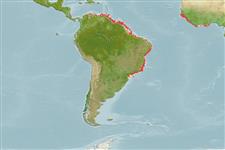Common names from other countries
Classification / Names / Names
Nomi Comuni | Sinonimi | Catalog of Fishes (gen., sp.) | ITIS | CoL | WoRMS
Environment: milieu / climate zone / depth range / distribution range
Ecologia
; distribuzione batimetrica 0 - 30 m (Ref. 83435). Tropical; 12°N - 28°S, 62°E - 0°E (Ref. 83435)
Atlantic Ocean: Trinidad and Tobago to Brazil, and tropical West Africa.
Length at first maturity / Size / Peso / Age
Maturity: Lm ? range ? - ? cm Max length : 16.6 cm DL maschio/sesso non determinato; (Ref. 83435); common length : 16.0 cm TL maschio/sesso non determinato; (Ref. 355)
Shell fusiform, spire high, anterior canal well developed, shell surface with sculpture of many fine spiral threads. Shoulder angular, with single row or nodules. Periostracum thick and hairy. Colour: chocolate brown to black, with a few contrasting white bands, periostracum brownish.
Lives on mud and other soft substrates in mangrove areas and near river estuaries. Feeds mainly on carrion (Ref. 355).
Life cycle and mating behavior
Maturità | Riproduzione | Deposizione | Uova | Fecundity | Larve
This species is a non-broadcast spawner. Life cycle does not include trocophore stage. Also Ref. 833.
Leal, J.H. 2003. (Ref. 355)
IUCN Red List Status (Ref. 130435)
CITES status (Ref. 108899)
Not Evaluated
Not Evaluated
Threat to humans
Harmless
Human uses
| FishSource |
Strumenti
Informazioni ulteriori
Age/SizeAccrescimentoLength-weightLength-lengthMorfologiaLarveAbbondanza
Fonti Internet
Estimates based on models
Preferred temperature
(Ref.
115969): 26.7 - 28.3, mean 27.5 (based on 255 cells).
Price category
Unknown.
